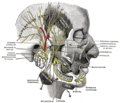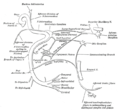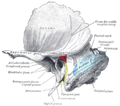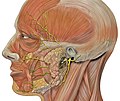Facial nerve
| Facial nerve | |
|---|---|
 The course of the facial nerve is shown here | |
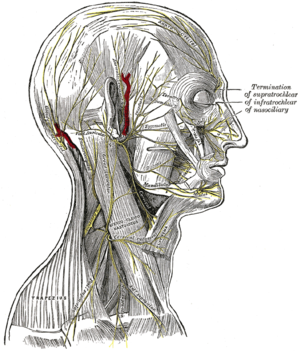 The nerves of the scalp, face, and side of neck. | |
| Details | |
| From | Facial nerve nucleus,intermediate nerve |
| To | Greater superficial petrosal nerve |
| Innervates | Motor:Muscles of facial expression,posterior belly of digastric,stylohyoid,stapedius Special sensory:tasteto anterior two-thirds oftongue Parasympathetic:submandibular gland,sublingual gland,lacrimal glands |
| Identifiers | |
| Latin | nervus facialis |
| MeSH | D005154 |
| NeuroNames | 551 |
| TA98 | A14.2.01.099 |
| TA2 | 6284 |
| FMA | 50868 |
| Anatomical terms of neuroanatomy | |
| Cranial nerves |
|---|
|
Thefacial nerve,also known as theseventh cranial nerve,cranial nerve VII,or simplyCN VII,is acranial nervethat emerges from theponsof thebrainstem,controls themuscles of facial expression,and functions in the conveyance oftastesensations from the anterior two-thirds of thetongue.[1][2]The nerve typically travels from the pons through thefacial canalin thetemporal boneand exits the skull at thestylomastoid foramen.[3]It arises from the brainstem from an area posterior to thecranial nerve VI(abducens nerve) and anterior tocranial nerve VIII(vestibulocochlear nerve).
The facial nerve also supplies preganglionicparasympatheticfibers to several head and neckganglia.
The facial andintermediate nervescan be collectively referred to as thenervus intermediofacialis.[citation needed]
Structure
[edit]The path of the facial nerve can be divided into six segments:
- intracranial (cisternal) segment (from brainstem pons to internal auditory canal)
- meatal (canalicular) segment (within the internal auditory canal)
- labyrinthine segment (internal auditory canal to geniculate ganglion)
- tympanic (or horizontal) segment (fromgeniculate gangliontopyramidal eminence)
- mastoid (or vertical) segment (from pyramidal eminence to stylomastoid foramen)
- extratemporal segment (from stylomastoid foramen to post parotid branches)
The motor part of the facial nerve arises from thefacial nerve nucleusin thepons,while the sensory and parasympathetic parts of the facial nerve arise from theintermediate nerve.
From the brain stem, the motor and sensory parts of the facial nerve join and traverse theposterior cranial fossabefore entering thepetrous temporal bonevia theinternal auditory meatus.Upon exiting the internal auditory meatus, the nerve then runs a tortuous course through thefacial canal,which is divided into the labyrinthine, tympanic, and mastoid segments.
The labyrinthine segment is the shortest and narrowest segment of the facial nerve and ends where the facial nerve forms a bend known as the geniculum of the facial nerve (genumeaning knee), which contains thegeniculate ganglionfor sensory nerve bodies. The first branch of the facial nerve, thegreater petrosal nerve,arises here from the geniculate ganglion. The greater petrosal nerve runs through thepterygoid canaland synapses at thepterygopalatine ganglion.Postsynaptic fibers of the greater petrosal nerve innervate thelacrimal gland.
In the tympanic segment, the facial nerve runs through thetympanic cavity,medial to theincus.
Thepyramidal eminenceis the second bend in the facial nerve, where the nerve runs downward as the mastoid segment, the longest segment of the facial nerve. In the temporal part of the facial canal, the nerve gives branch to thestapedius muscleandchorda tympani.The chorda tympani supplies taste fibers to the anterior two thirds of the tongue, and also synapses with thesubmandibular ganglion.Postsynaptic fibers from the submandibular ganglion supply thesublingualandsubmandibular glands.
Upon emerging from thestylomastoid foramen,the facial nerve gives rise to theposterior auricular branch.It then gives rise to the branch to the posterior belly of the digastric, and then the branch to the stylohyoid. The facial nerve then passes through theparotid gland,which it does not innervate, to form theparotid plexus.The nerve then bifurcates at thepes anserinusto become the upper and lower divisions of the facial nerve.[4]It then splits into five branches (temporal, zygomatic, buccal, marginal mandibular and cervical), innervating themuscles of facial expression.[5][6]
Intracranial branches
[edit]Thegreater petrosal nervearises at thesuperior salivatory nucleusof the pons and provides parasympathetic innervation to several glands, including thenasal glands,thepalatine glands,thelacrimal gland,and thepharyngeal gland.It also provides parasympathetic innervation to thesphenoid sinus,frontal sinus,maxillary sinus,ethmoid sinus,andnasal cavity.This nerve also includes taste fibers for thepalatevia thelesser palatine nerveandgreater palatine nerve.
The communicating branch to theotic ganglionarises at thegeniculate ganglionand joins thelesser petrosal nerveto reach the otic ganglion.[7]
Thenerve to stapediusprovides motor innervation for thestapedius musclein middle ear
Thechorda tympaniprovides parasympathetic innervation to the sublingual and submandibular glands, as well as special sensory taste fibers for the anterior two thirds of the tongue.[1]
Extracranial branches
[edit]Distal tostylomastoid foramen,the following nerves branch off the facial nerve:
- Posterior auricular nervewhich controls movements of some of the scalp muscles around the ear
- Branch to posterior belly ofdigastric muscle
- Branch of thestylohyoid muscle
- Five major facial branches (atparotid plexus) – from superior to inferior:
Intra operatively the facial nerve is recognized at 3 constant landmarks:[citation needed]
- At the tip oftraguswhere the nerve is 1 cm deep and inferior[8]
- At the posterior belly of digastric by tracing this backwards to the tympanic plate, the nerve can be found between these two structures
- By locating theposterior facial veinat the inferior aspect of the gland where the marginal branch would be seen crossing it.
- Lateral semicircular canal
- Foot of incus
Nucleus
[edit]Thecell bodiesfor the facial nerve are grouped in anatomical areas callednucleiorganglia.The cell bodies for the afferent nerves are found in thegeniculate ganglionfor taste sensation. The cell bodies for muscular efferent nerves are found in thefacial motor nucleuswhereas the cell bodies for the parasympathetic efferent nerves are found in thesuperior salivatory nucleus.
Development
[edit]The facial nerve is developmentally derived from the secondpharyngeal arch,or branchial arch. The second arch is called the hyoid arch because it contributes to the formation of the lesser horn and upper body of thehyoid bone(the rest of the hyoid is formed by the third arch). The facial nerve supplies motor and sensory innervation to the muscles formed by the second pharyngeal arch, including the muscles of facial expression, the posterior belly of the digastric, stylohyoid, and stapedius. The motor division of the facial nerve is derived from thebasal plateof the embryonic pons, while the sensory division originates from thecranial neural crest.[9]
Although the anterior two thirds of the tongue are derived from the first pharyngeal arch, which gives rise to the trigeminal nerve, not all innervation of the tongue is supplied by it. The lingual branch of themandibular division(V3) of thetrigeminal nervesupplies non-taste sensation (pressure, heat, texture) to the anterior part of the tongue viageneral somatic afferent fibers.Nerve fibers for taste are supplied by the chorda tympani branch of the facial nerve viaspecial visceral afferentfibers.[10]
Function
[edit]Facial expression
[edit]The main function of the facial nerve is motor control of all themuscles of facial expression.It also innervates the posterior belly of thedigastric muscle,thestylohyoid muscle,and thestapedius muscleof themiddle ear.Theseskeletal musclesare developed from thesecond pharyngeal arch.
Facial sensation
[edit]In addition, the facial nerve receivestastesensations from the anterior two-thirds of thetonguevia thechorda tympani.Taste sensation is sent to the gustatory portion (superior part) of thesolitary nucleus.General sensation from the anterior two-thirds of tongue are supplied by afferent fibers of the third division of the fifth cranial nerve (CN V-3). These sensory (CN V3) and taste (VII) fibers travel together as the lingual nerve briefly before the chorda tympani leaves the lingual nerve to enter the tympanic cavity (middle ear) via the petrotympanic fissure. It joins the rest of the facial nerve via the canaliculus for chorda tympani. The facial nerve then forms thegeniculate ganglion,which contains the cell bodies of the taste fibers of chorda tympani and other taste and sensory pathways. From the geniculate ganglion, the taste fibers continue as the intermediate nerve which goes to the upper anterior quadrant of the fundus of theinternal acoustic meatusalong with the motor root of the facial nerve. The intermediate nerve reaches the posterior cranial fossa via the internal acoustic meatus before synapsing in thesolitary nucleus.
The facial nerve also supplies a small amount of afferent innervation to theoropharynxbelow thepalatine tonsil.There is also a small amount of cutaneous sensation carried by thenervus intermediusfrom the skin in and around theauricle(outer ear).
Other
[edit]The facial nerve also suppliesparasympatheticfibers to thesubmandibular glandandsublingual glandsviachorda tympani.Parasympathetic innervation serves to increase the flow of saliva from these glands. It also supplies parasympathetic innervation to the nasal mucosa and thelacrimal glandvia thepterygopalatine ganglion.The parasympathetic fibers that travel in the facial nerve originate in thesuperior salivatory nucleus.
The facial nerve also functions as the efferent limb of thecorneal reflex.
Functional components
[edit]The facial nerve carries axons of type GSA,general somatic afferent,to skin of the posterior ear.
The facial nerve also carries axons of type GVE,general visceral efferent,which innervate the sublingual, submandibular, and lacrimal glands, also mucosa of nasal cavity.
Axons of type SVE,special visceral efferent,innervate muscles of facial expression, stapedius, the posterior belly of digastric, and the stylohyoid.
The axons of type SVA,special visceral afferent,provide taste to the anterior two-thirds of tongue viachorda tympani.
Clinical significance
[edit]Palsy
[edit]People may suffer fromacute facial nerve paralysis,which is usually manifested by facial paralysis.[11]Bell's palsyis one type ofidiopathicacute facial nerve paralysis, which is more accurately described as a multiple cranial nerve ganglionitis that involves the facial nerve, and most likely results from viral infection and also sometimes as a result ofLyme disease.Iatrogenic Bell's palsy may also be as a result of an incorrectly placed dental local-anesthetic (inferior alveolar nerve block). Although giving the appearance of a hemiplegic stroke, effects dissipate with the drug. When the facial nerve is permanently damaged due to a birth defect, trauma, or other disorder, surgery including a cross facial nerve graft or masseteric facial nerve transfer may be performed to help regain facial movement.[citation needed]Facial nerve decompressionsurgery is also sometimes carried out in certain cases of facial nerve compression.
Examination
[edit]Voluntary facial movements, such as wrinkling the brow, showing teeth, frowning, closing the eyes tightly (inability to do so is calledlagophthalmos),[12]pursing the lips and puffing out the cheeks, all test the facial nerve. There should be no noticeable asymmetry.
In anupper motor neuronlesion, calledcentral seven,only the lower part of the face on the contralateral side will be affected, due to the bilateral control to the upper facial muscles (frontalisandorbicularis oculi).
Lower motor neuronlesions can result in a CN VII palsy (Bell's palsy is the idiopathic form of facial nerve palsy), manifested as both upper and lower facial weakness on the same side of the lesion.
Taste can be tested on the anterior two-thirds of the tongue. This can be tested with a swab dipped in a flavored solution, or with electronic stimulation (similar to putting your tongue on a battery).
Corneal reflex.The afferent arc is mediated by the general sensory afferents of the trigeminal nerve. The efferent arc occurs via the facial nerve. The reflex involves consensual blinking of both eyes in response to stimulation of one eye. This is due to the facial nerves' innervation of the muscles of facial expression, namely orbicularis oculi, responsible for blinking. Thus, the corneal reflex effectively tests the proper functioning of both cranial nerves V and VII.
Additional images
[edit]-
Inferior view of the human brain, with the cranial nerves labelled.
-
Mandibular division of the trifacial nerve.
-
Plan of the facial and intermediate nerves and their communication with other nerves.
-
The course and connections of the facial nerve in thetemporal bone.
-
Upper part of medulla spinalis and hind- and mid-brains; posterior aspect, exposed in situ.
-
Left temporal bone showing surface markings for the tympanic antrum (red), transverse sinus (blue), and facial nerve (yellow).
-
Head facial nerve branches
-
Facial nerve. Deep dissection.
See also
[edit]References
[edit]![]() This article incorporates text in thepublic domainfrompage 901of the 20th edition ofGray's Anatomy(1918)
This article incorporates text in thepublic domainfrompage 901of the 20th edition ofGray's Anatomy(1918)
- ^ab"The Facial Nerve (CN VII)".TeachMeAnatomy.2013-09-04.Retrieved2018-05-04.
- ^"Facial nerve | anatomy".Encyclopedia Britannica.Retrieved2020-10-13.
- ^Kochhar A, Larian B, Azizzadeh B (April 2016). "Facial Nerve and Parotid Gland Anatomy".Otolaryngologic Clinics of North America.49(2): 273–84.doi:10.1016/j.otc.2015.10.002.PMID27040583.
- ^"Parotidectomy with Facial Nerve Dissections | Iowa Head and Neck Protocols".medicine.uiowa.edu.Retrieved2023-11-05.
- ^Gupta S, Mends F, Hagiwara M, Fatterpekar G, Roehm PC (2013)."Imaging the facial nerve: a contemporary review".Radiology Research and Practice.2013:248039.doi:10.1155/2013/248039.PMC3676972.PMID23766904.
- ^Snell RS (2011).Clinical Anatomy by Regions(Ninth ed.). Philadelphia, Pa.; London: LWW.ISBN9781451110326.
- ^Singh V.Textbook of Clinical Neuroanatomy(2nd ed.). p. 104.
- ^Saha S, Pal S, Sengupta M, Chowdhury K, Saha VP, Mondal L (January 2014)."Identification of facial nerve during parotidectomy: a combined anatomical & surgical study".Indian Journal of Otolaryngology and Head and Neck Surgery.66(1): 63–8.doi:10.1007/s12070-013-0669-z.PMC3938689.PMID24605304.
- ^Dudek RW (2014).BRS Embryology(Sixth ed.). LWW.ISBN9781451190380.
- ^Moore KL, Persaud TV, Torchia MG (2011).The Developing Human: Clinically Oriented Embryology with Student Consult Online Access, 9th Edition(9th ed.). Philadelphia, PA: Saunders.ISBN9781437720020.
- ^Masterson L, Vallis M, Quinlivan R, Prinsley P (September 2015). "Assessment and management of facial nerve palsy".BMJ.351:h3725.doi:10.1136/bmj.h3725.PMID26378061.S2CID206906594.
- ^Kliniska Färdigheter: Informationsutbytet Mellan Patient Och Läkare, LINDGREN, STEFAN,ISBN91-44-37271-X
External links
[edit]- Wikipedia articles incorporating text from the 20th edition of Gray's Anatomy (1918)
- Facial nerve
- Cranial nerves
- Motor system
- Innervation of the face
- Autonomic nervous system
- Gustatory system
- Human mouth anatomy
- Otorhinolaryngology
- Nerves of the head and neck
- Neurology
- Nervous system
- Parasympathetic nervous system


